
|
Keywords: Hubble Deep Field, HST, infrared
 Spitzer s Trifid
Spitzer s Trifid
13.02.2020
The Trifid Nebula, also known as Messier 20, is easy to find with a small telescope. About 30 light-years across and 5,500 light-years distant it's a popular stop for cosmic tourists in the nebula rich constellation Sagittarius.
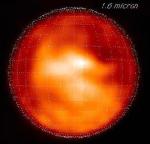 The Surface of Titan
The Surface of Titan
20.08.2000
If sailing the hydrocarbon seas of Titan, beware of gasoline rain. Such might be a travel advisory issued one future day for adventurers visiting Titan, the largest moon of Saturn. New images of Titan's surface were released last week from the Canada-France Hawaii Telescope featuring the finest details yet resolved.
 APOD: 2020 July 26 Б A Flight through the Hubble Ultra Deep Field
APOD: 2020 July 26 Б A Flight through the Hubble Ultra Deep Field
26.07.2020
What would it look like to fly through the distant universe? To find out, a team of astronomers estimated the relative distances to over 5,000 galaxies in one of the most distant fields of galaxies ever imaged: the Hubble Ultra Deep Field (HUDF).
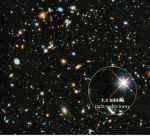 The Hubble Ultra Deep Field in Light and Sound
The Hubble Ultra Deep Field in Light and Sound
2.08.2021
Have you heard about the Hubble Ultra-Deep Field? Either way, you've likely not heard about it like this -- please run your cursor over the featured image and listen! The Hubble Ultra-Deep Field (HUDF)...
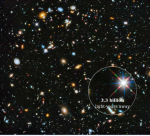 APOD: 2025 March 2 Б The Hubble Ultra Deep Field in Light and Sound
APOD: 2025 March 2 Б The Hubble Ultra Deep Field in Light and Sound
2.03.2025
Have you heard about the Hubble Ultra-Deep Field? Either way, you've likely not heard about it like this -- please run your cursor over the featured image and listen! The Hubble Ultra-Deep Field (HUDF)...
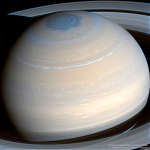 Saturn in Infrared from Cassini
Saturn in Infrared from Cassini
24.07.2022
Many details of Saturn appear clearly in infrared light. Bands of clouds show great structure, including long stretching storms. Also quite striking in infrared is the unusual hexagonal cloud pattern surrounding Saturn's North Pole. Each side of the dark hexagon spans roughly the width of our Earth.
 APOD: 2025 February 23 Б Saturn in Infrared from Cassini
APOD: 2025 February 23 Б Saturn in Infrared from Cassini
23.02.2025
Saturn looks slightly different in infrared light. Bands of clouds show great structure, including long stretching storms. Also quite striking in infrared is the unusual hexagonal cloud pattern surrounding Saturn's North Pole. Each side of the dark hexagon spans roughly the width of our Earth.
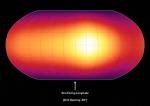 HD 189733b: Hot Jupiter
HD 189733b: Hot Jupiter
12.05.2007
HD 189733b is a Jupiter-sized planet known to orbit a star some 63 light-years away. But while the distant world is approximately the size of Jupiter, its close-in orbit makes it much hotter than our solar system's ruling gas giant.
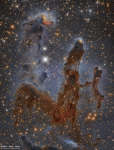 Pillars of the Eagle Nebula in Infrared
Pillars of the Eagle Nebula in Infrared
7.03.2021
Newborn stars are forming in the Eagle Nebula. Gravitationally contracting in pillars of dense gas and dust, the intense radiation of these newly-formed bright stars is causing surrounding material to boil away. This image...
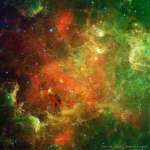 The North America Nebula in Infrared
The North America Nebula in Infrared
28.07.2019
The North America Nebula can do what most North Americans cannot -- form stars. Precisely where in the nebula these stars are forming has been mostly obscured by some of the nebula's thick dust that is opaque to visible light.
|
January February March April May June July |
|||||||||||||||||||||||||||||||||||||||||||||||||